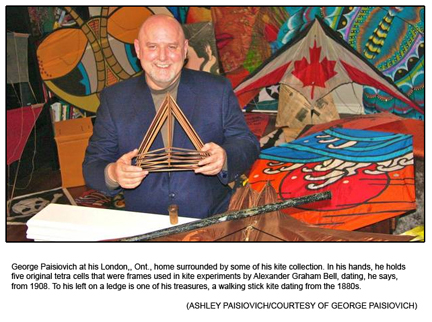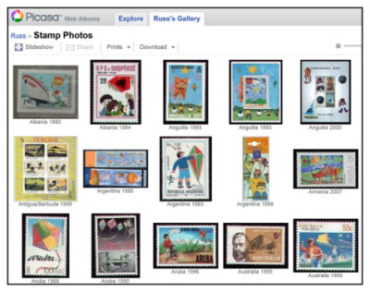Time Flies!
As a young boy I can remember my Dad saying: "The older you get, the faster time goes by." At the time, I thought that was a ridiculous statement; surely time was a constant and moved at it's own regular pace. Usually my Dad was a wise old guy, but this statement always seemed to be incongruous when compared with his usual practical wisdom.
Now, after the passage of many years, I too recognize the phenomenon of time seeming to speed up; to go by more quickly. There are occasions when something occurs and one is suddenly reminded that time has passed by so swiftly.
Recently I was reflecting on the emergence of the Internet and web-based information on the modern kiting scene. In 1990 when commercial Internet services were becoming common place, a series of modest news groups began to link kiters from diverse regions in conversations about kites and kiting.
To me, a person with a then rather obscure hobby of building and flying kites, this was like striking gold. Suddenly there was a location where one could ask questions, find answers and learn about others in the hobby. I learned of kite clubs and kite festivals and began to travel to see some of the kites I was hearing about on the Internet. Grand Haven, MI; Wildwood, NJ; Ocean City, MD; Cleveland, OH - all places with established festivals suddenly became destinations for a new kind of family travel.
By 1998 energetic and visionary kiters were talking about the need for an on-line kite magazine. The gold standard of print magazines, Kitelines, was struggling to put out editions in a regular and timely sequence. By 1996 there was discussion that perhaps there was an opportunity that this new found synergy of kiters conversing on-line could turn into an on-line magazine.
By 1998 Mike Gillard of Columbus, OH turned that talk into action. Founding Kitelife, the online journal of kiting in April, 1998, Mike created a respected gathering place for kite information and the ongoing record of the development of kites and kiting that continues to this day under the direction of his former kite flying team mate, John Barressi (well known founder of the performance kite team iQuad).1
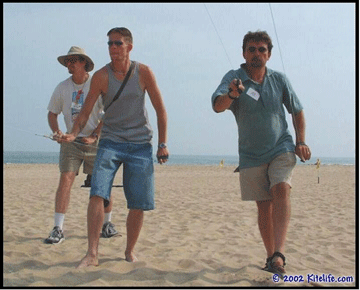 Mike Gillard (right), John Barresi (center) and Vern Balodis (left) flying as Team Captain Eddie's Flying Circus at Grand Haven, MI (2002)
Mike Gillard (right), John Barresi (center) and Vern Balodis (left) flying as Team Captain Eddie's Flying Circus at Grand Haven, MI (2002)
While searching out a bit of kite information I turned to the KiteLife site on the Internet and suddenly it occurred to me again: -time has certainly marched on, and very swiftly.
I came across a series of entries in the early editions of KiteLife that I had authored or that featured photos that I was tagged in. Suddenly 1998 was back before me; could it really be that a decade and a half had slipped by in a blink? How was it that time had moved so quickly. In some ways the stories and images were just like they had happened, seconds ago; in other ways there were clear signs that time had relentlessly rolled on. Perhaps it is true: "The older you get, the faster time goes by."
I have, for the sake of nostalgia, pulled a couple of stories from the early era of KiteLife into this blog posting. Reminisence is good and it brings a flood of memories of times, places and people that mean so much to us and make us who we are. I just thought that I would share some of them with you.
- Moving Along! George Pocock and the Beginnings of Modern Traction Kiting.
- Kite History 101 - Guglielmo Marconi.
- Japan-Canada Fly (Niagara Falls, ON, 1998).
________________
1 Mike Gillard passed away on Feb. 28, 2006. The direction of KiteLife was taken over by John Barresi after Mike's death. It continues today as the premier on-line kiting journal. Ref: http://www.kitelife.com/old-issues/issue-47-empty-spaces-mike-gillard/
Ted Shaw - Western New York Kiter a strong force in promoting kiting.
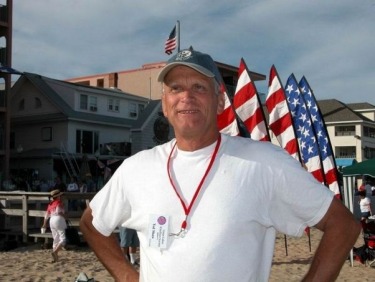 Photo - The Buffalo News - May 19, 2013 (Michelle Kearns)Ted Shaw has been involved in kiting for over twenty years. Drawn to kites by viewing their simple beauty as they hung in the air at a kite festival known as "Paint the Sky" hosted by the Great Lakes Kitefliers Society (GLKS) of Western New York, Ted has now become President of the association.
Photo - The Buffalo News - May 19, 2013 (Michelle Kearns)Ted Shaw has been involved in kiting for over twenty years. Drawn to kites by viewing their simple beauty as they hung in the air at a kite festival known as "Paint the Sky" hosted by the Great Lakes Kitefliers Society (GLKS) of Western New York, Ted has now become President of the association.
I have had the pleasure of knowing Ted for all of those twenty years. I first ran into him when I was at a kiting event run by GLKS shortly after he had joined the group. He was just getting started then, but his inquisitive engineering mind led hem to ask all kinds of questions about kites, how they were made and how they flew. You could tell immediately that he was going to be serious about this activity.
Over the ensuing years Ted and I became good friends. We have travelled together to over two dozen kiting events, many far afield, and we have thoroughly enjoyed each other's company. He has a dry, wicked sense of humor and we have shared numerous laughs. As it turns out he spent many of his teenage years in Long Beach, Ontario at a summer cottage only a few miles from my home. As we reminisced we told tales of roller skating in the Long Beach Roller Rink and we wondered if we had actually been in the same crowd at the same time even though we did not know each other then.
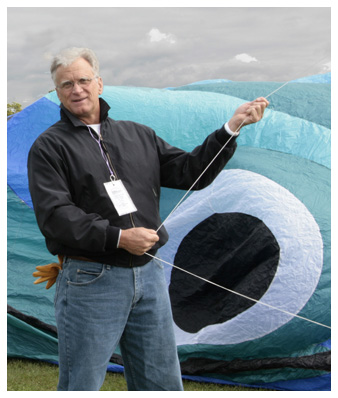 Ted flying at kite - NIKF 2008, Niagara Falls, NYTed has become one of the great ambassadors of kiting. He builds most of his own kites, hosts workshops in his spacious barn studio on his property, is involved heavily in GLKS his local club, and travels to many events put on by the Niagara Windriders, the Kitchener-Waterloo Wind Climbers and the Toronto Kite Fliers.
Ted flying at kite - NIKF 2008, Niagara Falls, NYTed has become one of the great ambassadors of kiting. He builds most of his own kites, hosts workshops in his spacious barn studio on his property, is involved heavily in GLKS his local club, and travels to many events put on by the Niagara Windriders, the Kitchener-Waterloo Wind Climbers and the Toronto Kite Fliers.
Ted constantly promotes kite flying at these and other events. You will often see him walking along the perimeter of a kite festival field with a kite high on the end of the line. Stopping here and there he passes his kite line into the hands of a stranger and tells them all there is to know about kite flying. Entranced, these folks often break out with a big smile and carry on long conversations. I suspect that for many of them this little interlude is the high point of their day and it leaves a positive image of kiters and kite flying.
The Buffalo News, in its May 19, 2013 edition, did a well deserved feature article about Ted, a fine flyer I am proud to call my friend.
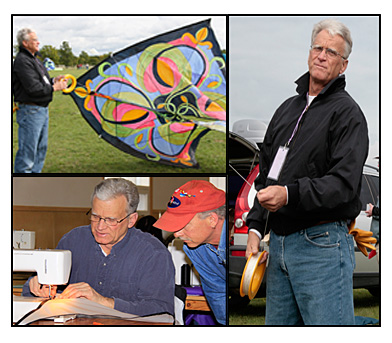 Top left - Ted flying his Boreal Kites custom delta; Bottom left - kitemaking at a Niagara Windriders clinic; Right - holding a kite line at the NIKF festival 2008
Top left - Ted flying his Boreal Kites custom delta; Bottom left - kitemaking at a Niagara Windriders clinic; Right - holding a kite line at the NIKF festival 2008
Tribute to a Great Canadian Kiter - Carlos Simoes
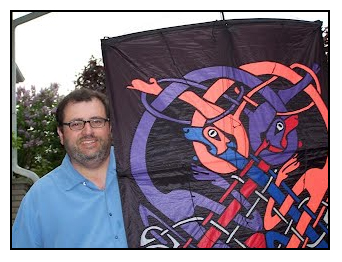 Kiting seems to have more than its share of fine people committed to the hobby/sport. It is generally characterized by people who love to share: share the sky, share building tips, share flying techniques and share personal friendship.
Kiting seems to have more than its share of fine people committed to the hobby/sport. It is generally characterized by people who love to share: share the sky, share building tips, share flying techniques and share personal friendship.
No one exemplifies this better than Carlos Simoes of Cambridge, ON. Carlos is a wonderful person, fine family man and highly skilled kiter who simply loves to build and fly kites in a sky that he shares with friends all across North America.
The Kitchener-Waterloo Record newspaper did a feature on Carlos that shows his deep love of kites, the sky and the people who share his passion for tethered flight.
I am indeed fortunate to have Carlos as a close friend and compatriot of the winds! I hope you enjoy this well deserved tribute to a guy I call my 'Wing Man'.
Helping to Preserve Kite History - George Paisiovich
I first met George Paisiovich at a kiting event in Vineland, ON. I had not known him before the event, but he captured my attention immediately.
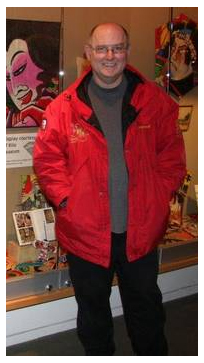 I was adjusting the line on a kite that I had launched and looked back towards the sidelines of the flying field when my eye caught a Steiff Roloplan kite being launched into the blue sky. What immediately struck me was the fact that the kite was not a replica; it was an original from the early 1900's. You could tell immediately that this kite was both pristine and old; something you just do not see flown in ordinary circumstances.
I was adjusting the line on a kite that I had launched and looked back towards the sidelines of the flying field when my eye caught a Steiff Roloplan kite being launched into the blue sky. What immediately struck me was the fact that the kite was not a replica; it was an original from the early 1900's. You could tell immediately that this kite was both pristine and old; something you just do not see flown in ordinary circumstances.
I walked over to the kiter at the end of the Steiff line and asked the obvious: "Is that an original Steiff?" George answered with a huge smile, '"Yes, isn't it a beauty?" I agreed and was somewhat dumbfounded that a kite of this vintage and value would be flown at an ordinary kite event.
What I did not realize at the time was that this simple deed of flying a valuable kite treasure as an ordinary act really exemplifies George Paisiovich.
George is passionate about kites and kite history. He is the Director of the Kite Museum of Canada. George is currently in the process of moving the collection from its initial site on Pelee Island to London, ON.
I have spent countless hours talking with George about kites and their history. The word that most often comes to mind when I think of his connection to kites is the word joy. George admires the beauty and elegance of each kite that he collects. He takes delight in gathering up old black and white photos of ordinary people, kids and adults alike, flying kites in the past. He will often say: "Look at their smiles" -or- "Doesn't that just capture the essence of kite flying".
I have also come to know that George feels a strong need to save kite artifacts for Canada and Canadians. He wants this country to have its own connection to kites of the past and to the kite heritage that is uniquely Canadian. To that end, he has worked with Parks Canada, the A.G. Bell National Historic Site in Baddeck, and the Bell family to promote wide knowledge among Canadians of the rich kiting and aviation heritage that springs from the kite work of Alexander Graham Bell in Nova Scotia.
At the same time as he works to gather kite artifacts, George knows that he is only the temporary custodian of the past. He relishes the joy of sharing the kites in a new museum and exhibition setting that he is working to establish in the coming years in his home of London, ON.
Recently an article in the business section of Canada's Globe and Mail newspaper featured a story about George and his collection of historic kites and kiting artifacts. Read it and I think you will have some insights into the joy that George derives from kites and from sharing their story.
Kite Stamp Collecting - A source of knowledge about kites around the world.
Kites are often regarded as a universal device that are present in the culture of most nations of the world. As evidence of this, one only needs to look at stamps that depict kites which have been issued in a multitude of nations.
Russ Mozier of Florida has compiled an outstanding set of over 300 kite stamps from around the world. Russ' Picasa page of kite stamps shows them in both individual photos and in a slide show format.
The site is well worth browsing. You will see a wide variety of stamps with kites on them. Many show the kites that are indigenous to the culture of the nation issuing the stamp. These stamps are another interesting source of learning about kites around the world. Other kite stamps in the collection show significant events in the history of kite design (e.g the Australian kites of kite pioneer Lawrence Hargrave).
I first met Russ and his wife Pat Mozier at a Kite Festival in Wildwood, NJ in 2004. At that time Russ and Pat were members of the South Jersey Kite Flyers. They conducted a workshop on small kites that can be used with children in classrooms and which can be built at almost no cost. I have used the Sode kite design that Russ and Pat so capably demonstrated in hundreds of workshops since that event. The kite is now a staple of workshops given to children by both the Niagara Windriders Kitefliers Association and by the Toronto Kitefliers who adopted it after I introduced them to the design in 2011.
Recently Russ and Pat moved to Florida where they are now membera of the Central Florida Kite Club. Russ and Pat have their own web site, Kids Kitemaking, where you can learn more about their work with children and kites.




